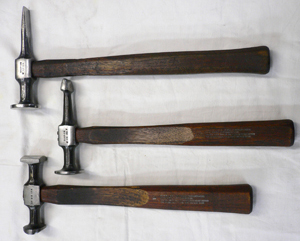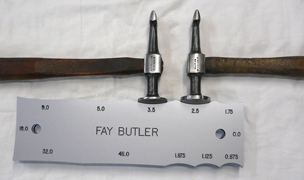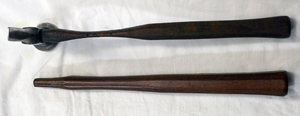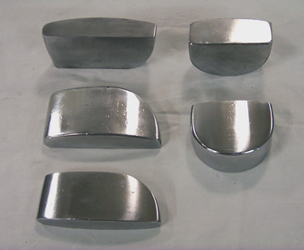Fay Butler Fab/Metal Shaping
Body Hammer and Dolly
|
Any person working auto body sheet metal will need good body hammers. The Snap-on line of body hammers and dollies are hands down the best in the world although there are other companies that sell acceptable hammers. Some of the features I like about the Snap-on line of hammers are the 8 sided hammer handle. Having facets on the handle allows one to subconsciously orientate the hammer from feel. With a smooth handle hammer which other manufactures use, this is not possible. I also like the way the hammer handles are put in at the eye of the steel hammer head. A wooden wedge is placed parallel to the force of the hammer, and two steel wedges are placed perpendicular to the load. This gives maximum force to the wood in the direction of load, keeping the handles tight to the steel heads. Last I like the alloy steel used which is very tough and the faces are not easily nicked. I recommend using them just as they are purchased from Snap-on, or with a couple of modifications spoken about below.
Pictured here are my three favorite hammers which are made by Snap-on; the optional BF615, then the two must have hammers: BF618 and BF604. I have been using these three from my first days of shaping metal, when Larry Amsley from Chambersburg PA, the guy that got me on my feet for shaping metal told me I need these three hammers. The BF615 is used for turning inside flanges. The BF618 is a roughing hammer used in higher crown areas. The BF604 is a finishing hammer used in lower crown areas. Both of these last hammers have a chisel shaped end giving a “linear stretch”. |
 |
 |
The first modification is the high crown hammer #BF 618. It comes with a 2.5” radius and for me that is a little to sharp. So I redress the center area, or about half the face where the work is actually taking place, sanding it somewhere between a 3.5” to a 4” radius. |
The second modification that I do is cut the handle down at the neck. I leave the width the same, but the thickness I cut down to slightly over ¼” or about .270”. This isolates the shock load from your body. I perform this modification to all my hammers. Fiberglass and steel handles are difficult to modify and do not have a faceted handle, I do not recommend their use. |
 |
|
For an individual looking for more hammer variations, I would recommend three more Snap-on hammers pictured in this order. From the left is BF608. This hammer is essentially the same as the BF604 except the chisel end is curved giving you a variation. The next hammer is a stock BF 618 where the contacts are 2.5.” Then is the BF 606 which happens to be the heaviest body hammer Snap-on makes. I like the square face for use in corners. |
| Notice there is not a pick hammer here. I do not ever recommend using one. A small pointed contact gives you a small punch like impression into the metal, leaving a rough finish. If you need to use a pick hammer in those rare instances, then use one of the chisel ends slightly caulked to the side so you are only using the very end. Not a recommended technique but for those of you that think you need a pick hammer, well that should satisfy your needs and help to wean you off of the pick. Also you should definitely consider a soft copper hammer. For safety reasons you should never hit two hardened steel hammers together. You risk chipping your hammer, potentially hurting you and destroying your hammer. | |
 |
Pictured are two styles of dollies which I constantly use, the toe and the heel dollies. The three pictured on the left are toe dollies and the two on the right are heel dollies. The weight of a dolly should be two to three times the weight of the hammer you are using so the dolly will not bounce. The dolly should be made of good alloy steel so it stays smooth. As you acquire other style dollies these should provide you with a larger variety of edge and surface radii. |
©2005-2007 Fay Butler